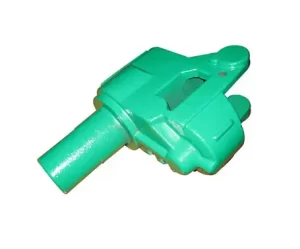The Development and Process of Lost Foam Casting
In 1958, H.F. Shroyer invented and patented the technology of using expandable foam molds to make metal castings. The original model used was made of polystyrene (EPS) sheets and molded with binder-containing molding sand. The German company Grunzweig and Harrtmann purchased this patent and developed and applied it. The technology of using binder-free dry sand to produce castings was later patented by T.R. Smith in 1964. Before 1980, the use of the binder-free dry sand process had to be approved by Full Mold Process, Inc. After that, the patent was invalid.

The most common and practical method is to put the model coated with refractory material into a sand box, fill it tightly with dry sand around the model, and pour liquid metal to replace the foam plastic model. This casting process is called: lost foam casting ( EPC), gasification mold casting and solid mold casting, etc. The Lost Foam Casting Committee of the American Foundry Association adopted “lost foam casting” as the name for the process.
Lost foam casting is an innovative casting process that can be used to produce non-ferrous and ferrous metal power system parts, including automotive castings such as cylinder blocks, cylinder heads, crankshafts, gearboxes, intake pipes, exhaust pipes and brake hubs.
The process flow of lost foam casting
1) Pre-foaming
Model production is the first step in the lost foam casting process. Complex castings such as cylinder heads require several pieces of foam models to be produced separately and then glued together into an overall model. Each block model requires a set of molds for production. In addition, a set of molds may be required during the gluing operation to maintain the accurate positioning of each block. The molding process of the model is divided into two steps. The first step is to Polystyrene beads are pre-expanded to an appropriate density, usually by rapid heating with steam. This stage is called pre-expansion.
2) Model shaping
The pre-expanded beads must be stabilized first, and then sent to the hopper of the molding machine, where they are fed through the feeding hole. After the mold cavity is filled with the pre-expanded beads, steam begins to be introduced to soften the beads. Expanding, filling all the voids and bonding into one body, this completes the manufacturing process of the foam model. This stage is called autoclaving.
After molding, the model is cooled by a large flow of water in the water-cooling cavity of the mold, and then the mold is opened to take out the model. At this time, the temperature of the model increases and its strength is low. Therefore, care must be taken during demoulding and storage to prevent deformation and damage.
3) Model cluster combination
Before use, the model must be stored for an appropriate period of time to mature and stabilize. The typical model storage period is up to 30 days, while models formed with uniquely designed molds only need to be stored for 2 hours. After the model is matured and stabilized, it can be divided into two parts. Block models are glued together.
The segmented model is glued using hot melt glue on an automatic gluing machine. Glued surface joints should be tightly sealed to reduce the possibility of casting defects
4) Model cluster dip coating
In order to produce more castings per box, sometimes many models are glued together into clusters, the model clusters are immersed in refractory paint, and then dried in an air circulation oven at about 30 to 60C (86-140F) for 2 to 3 cycles Hours, after drying, put the model cluster into the sand box, fill it with dry sand and vibrate for compaction. The dry sand inside and outside the cavity of all model clusters must be compacted and supported.
5) Pouring
After the model cluster is filled solidly in the sand box through dry sand vibration, the mold can be poured. After the molten metal is poured into the mold (the pouring temperature for cast aluminum is about 760C/1400F, and the cast iron is about 1425C/2600F), the model is vaporized and Metal is replaced to form a casting. Figure 1 is a schematic diagram of the sand box and pouring of the lost foam process.
In the lost foam casting process, the pouring speed is more critical than traditional hollow casting. If the pouring process is interrupted, the sand mold may collapse and become scrap. Therefore, in order to reduce the difference between each pouring, it is best to use an automatic pouring machine.
6) Falling sand cleaning
After pouring, the casting solidifies and cools in a sandbox and is then shaken out. Casting shakeout is fairly simple, the casting falls out of the loose dry sand by tipping the flask. The castings are then automatically separated, cleaned, inspected and placed in casting bins for transport.
Dry sand can be reused after cooling, and other additional processes are rarely used. Metal scraps can be remelted and used in production.
Advantages of lost foam casting process
The lost foam casting process has three main advantages in technology, economy and environmental protection.
1 Technical aspects
1) Increased degree of freedom in model design
The new process makes it possible to design and add additional features to the model from the first stage. For example: the diesel preheater has a special functional component that can be manufactured using the lost foam casting process but cannot be produced using traditional casting methods.
2) Eliminate the need for sand cores used in casting production
3) Many castings do not need riser feeding.
4) Improve casting accuracy
It can obtain complex shapes and structures, can produce high-precision castings 100 times repeatedly, and can control the wall thickness deviation of castings between -0.15~+0.15mm.
5) No flash will be produced on the joint surface of the model
6) It has the advantage of reducing the weight of castings by about 1/3
7) Reduce machining allowance
The machining allowance can be reduced, and some parts may not even be processed. This significantly reduces machining and machine tool investment (for example, investment can be reduced by half for different situations).
8) Compared with traditional cavity casting, mold investment is reduced.
9) Completely eliminate the traditional sand shakeout and core removal processes
2 Economic aspects
1) Complex castings can be produced as a whole
Using a new process design, the block model can be glued to form an overall model and cast into complex integral parts. Compared with the original assembly of multiple castings (such as a diesel preheater), the benefits can be 1 to 10 times.
2) Reduce workshop personnel
Setting up a lost foam casting plant requires fewer employees than a traditional foundry, so this factor should be taken into consideration.
3) Flexible casting process
The flexibility of the casting process is very important, because the new process has the possibility to simultaneously produce a large number of similar or different castings placed in the sand box, and the gating system is therefore very flexible. In conclusion, we can say that each advantage is consistent with economic benefits and at the same time improves working conditions.
3 Environmental protection
Polystyrene and PMMA produce carbon monoxide, carbon dioxide, water and other hydrocarbon gases when burned, and their contents are all lower than the European standards. Dry sand can use natural silica sand, which is 100% recycled and contains no binder. The paint used in the model is composed of water with binders and other auxiliary materials added, which does not cause pollution.
